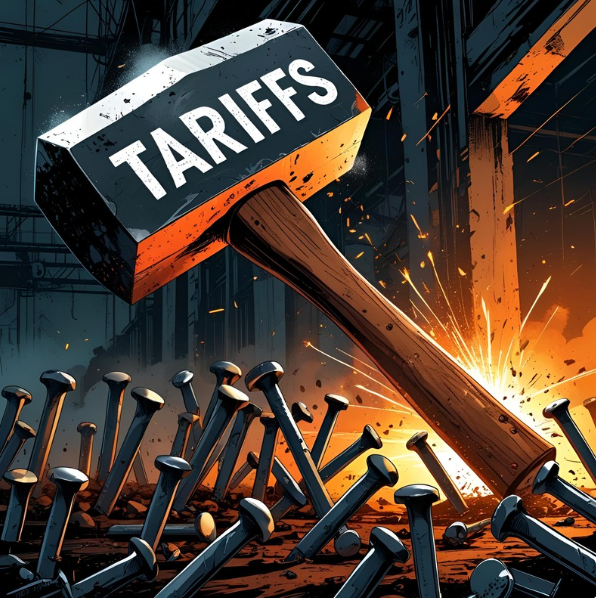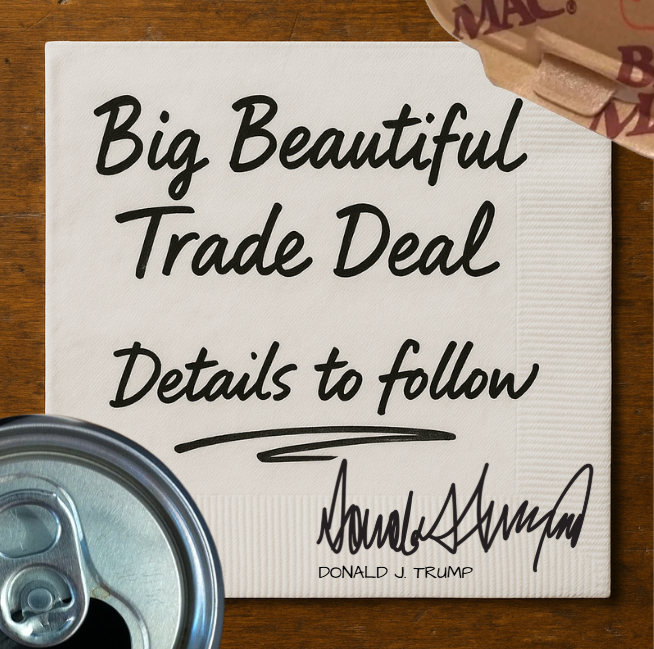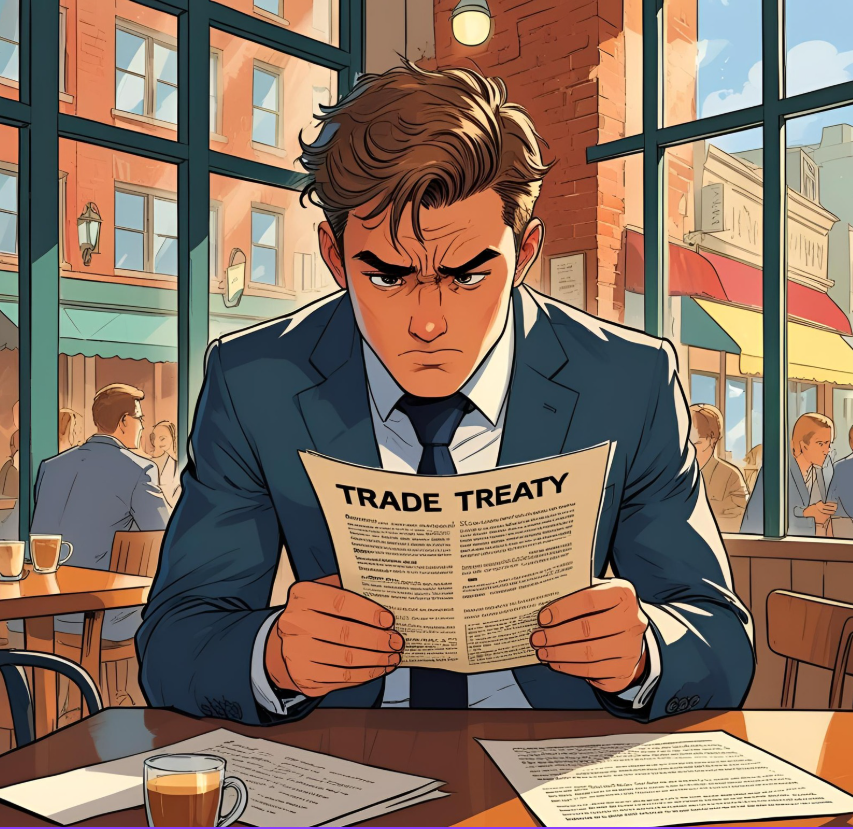How to Tariff Friends and Influence People
September 6, 2025
Articles
00
min read time
Dmitry Grozoubinski

I have on occasion been less than complimentary about the Trump administration’s tariff policy, and so I spend a lot of time thinking about how I would go about trying to achieve the goals they’ve set with the tools they like. You can imagine how fun I am at parties.
Recently I wrote about why I think the Trump administration’s attempts to use tariffs to secure concessions abroad have generated only limited successes beyond largely staving off immediate retaliation - and now I’d like to build on that by spending a few hundred words on the characteristics I think a more effective international influence strategy centered around tariffs would have.
Some Preambular Throat Clearing
Let me begin by getting some points out of the way so that you don’t spend the rest of this piece fuming at me about them.
Yes, tariffs are taxes that overwhelmingly fall on one’s own citizens and businesses.
Just the threat of them can disrupt supply chains and business deals, and even an exempt trader may have to pay much more in paperwork and compliance to navigate them when they exist. As with any tax that means the goals we hope to achieve with them have to be balanced with the costs they impose on those subject to them, and on the country at large. Those impacts can be considerable.
Yes, much of the below assumes the Trump administration is focused on its stated objectives.
I can appreciate why many would dismiss that and suggest a less charitable assumption like that they are focused on chaos for its own sake, political showmanship, opportunities for personal enrichment, or just getting through the day in a wild royal court governed by the whims and moods of an unpredictable president.
Opinions on the true motivations of the Trump administration may vary, and would propose you read the below as a general meditation on the utility of tariffs in service of foreign policy rather than focusing on who is currently in the White House.
Which brings us to, yes, most of the below assumes a level of focus and competence that not everyone believes the Trump administration has thus far consistently demonstrated.
Again, I would encourage you to separate the stage directions below from the current crop of actors occupying the theatre- even if only to hold up a mirror so as to better evaluate their performance.
Principle One: Know Thyself
I know this sounds like wisdom I should be dispensing ahead of the big karate tournament after I tricked you into waxing my car, but any attempt to weaponize your tariff regime against a foreign player has to begin with a deep look at your own economy, its dependencies, and its resilience.
If you’re looking to convince a foreign government that you’re willing to tax your own citizens out of purchasing their products, that government has to believe:
- You are politically and legally capable of implementing such tariffs;
- You are bureaucratically capable of rolling them out with at least enough consistency of enforcement that businesses alter their behaviour;
- That your citizens and businesses can live without the products in question or source them elsewhere;
- That there are no obvious and unplanned for vulnerabilities or dependencies a target of tariffs could exploit to force you to back down by retaliating on; and
- That you can sustain points 1-4 for a meaningful period of time.
Things you want to avoid include:
- Discovering that much of the constitutional edifice you’ve built your tariff threats on is less than solid.
- Discovering that your IT systems at the border aren’t ready for the flood of new measures they’ll have to apply.
- Discovering a few weeks into your big aggressive trade war with a major trading partner that you really need their magnets.
Principle Two: Know Thy Frenemy
In addition to reflecting on how the trading regime you’re targeting might respond to a tariff offensive, it’s important to properly assess a few other things about them.
First, obviously - what do they sell to you and to what extent would tariffs hurt them?
You want to have a realistic sense of your economic leverage, and this is not necessarily a straightforward thing to calculate.
To name just two examples, a nationally significant industry can be a vulnerability even when it accounts for only a modest amount of sales and a large volume of sales can be misleading if the product is a non-fungible globally traded commodity or something unavailable from other sources.
There’s also the critical question of whether the other government fears tariffs generally - or comparatively vis a vis their primary competitors. If you are Japan then having a 30% tariff into the United States is bad. However having a 30% tariff into the United States while Korea and the EU do not is terrible.
Second, to what extent is there decision making likely to be driven by economic considerations?
A common bias it’s natural to fall into is a hyperawareness of all the personal, political, bureaucratic, and systemic factors that drive decisions in one’s own system - while assuming others are hyperrational economic actors that would never cut off their financial noses to spite their populist faces.
Other governments can and will prove recalcitrant on points you think the economic math says they should probably yield on, and more flexible in areas where the numbers suggest they should fight you to the death. Which brings us neatly to…
Principle Three: Pick Thy Targets
An often frustrating thing about trade policy is that, especially when it comes to wealthier developed countries, most of the low-hanging fruit in trade negotiations has long ago been plucked and eaten. In other words, governments have generally already reduced their higher tariffs on everything except the products they really want to protect.
We see this most often but not exclusively in agriculture - where a country like Japan that has a 3.9% average tariff will suddenly have tariffs in the hundreds of percentage points on rice imports - the preservation and protection of which it considers nationally and politically vital.
With some exceptions, this means that the greatest potential gains to be made when it comes to opening new markets come on the most difficult political terrain. A high tariff means a lot of money to be made if you can convince the other government to drop it, but it also probably means that the government has strong domestic interests that will defend that tariff staying at its current level.
Beyond tariffs, some issues, industries, and even individual regulations can be totemic or have political resonance that seems disproportionate to what you as an external observer might feel like they should. The UK fishing industry proved absolutely pivotal in Brexit negotiations, despite employing fewer people and contributing less to GDP than some supermarkets, and the issue of chlorine washed chicken is an absolute third rail when it comes to negotiations with the US.
If your goal is to use secure maximum gains from the other side, you have to balance the potential upside of addressing a given barrier with its difficulty. Pushing another government on a big barrier they can’t move on may ultimately prove less effective than feinting in that direction before pivoting to asking for five other things that wouldn’t be as lucrative individually but which even collectively are less of a red line.
Principle Four: Tailor Thy Message
Ultimately, your success or failure in a negotiation will depend significantly on the ability of the leaders you’re engaging with to sell a story about the deal to their stakeholders, coalition partners, member states, constituents, and voters. If you want to maximize your chances, you have to be thinking about what that story will be, and the character they need you to play in order to sell it.
In some cases, the story will be that they managed to successfully stave off a larger threat through adroit diplomacy and negotiations. Here, you have to both be willing to play up the potential tariffs you might have imposed, and to make a big deal of what skilled interlocutors they were.
In other cases, where any perception of yielding to being bullied or cajoled is politically toxic, your goal might be to try to frame as much of the deal as possible as a win-win, a regrettable but necessary accommodation or a common effort to address shared problems.
There could be a tension here between your preferred message domestically and what kind of communications posture is most conducive to maximising negotiated outcomes - but it can be managed. Most governments understand and have some patience for the fact that when at home, you may have to spike the football or exaggerate the scale or balance of any deals struck. They just don’t want to be standing next to you when you do it.
The one thing you don’t want to do is signal with your every breath that a joint press conference announcing a deal alongside you will be an exercise in personal or national humiliation wherein you'll imply they gave up far more than they should have due to personal failings as a negotiator, leader and where relevant, man (their words, not mine!).
Principle Five: Signal Thy Permanence
No matter how you tailor your messaging and pick your targets, there is simply an extent to which any attempt to use tariffs to negotiate concessions abroad will resemble a shakedown. You are at the end of the day threatening others with loss of access to your market if they do not change things about the way their trade regime works.
When faced with that kind of pressure, two key points of internal opposition the other side will have to overcome relate to the permanence of the measures you’re threatening and the permanence of any deal they strike with you.
I have already spoken about how having solid legal footing for your threats is important - but anything else you can do to signal that if imposed they are here to stay may also be helpful. Building a broad domestic political consensus around tariffs could signal that upcoming elections won’t grant a reprieve, and passing a legislative act makes them feel significantly more enshrined.
Additionally, as I’ve also written about before, the other side will be keenly aware that imposing tariffs is something you can (legal challenges aside) do at any time, including after a deal is reached.
Any leader looking to strike a deal with you to get rid of the tariffs you’re threatening today will have to convince their stakeholders that you won’t be back next week with fresh threats alongside new demands, and that if a deal isn’t reached the tariffs will be here to stay for the foreseeable future.
Of course, tariffs of a significantly threatening nature in the short term may still compel some concessions simply because the consequences are so great that neither the possibility you may come back with more or that something may come along to undo them even without a deal is sufficient to completely deter engagement - but permanence allows you to charge a higher price.
More broadly, a greater sense of permanence will provide businesses and investors the certainty they’re craving in a newly chaotic trade world, and will increase the likelihood that the moves you’re making translate into the concrete economic changes you’re hoping to foster.
Principle Six: Have Thyself a Vision
Your country can’t make everything and it certainly can’t make everything tomorrow. If you are determined to improve access to foreign markets and encourage certain forms of production to grow within your territory, then you need a fairly robust understanding of what those forms of production are, what elements of them are realistic to competitively produce at home, and to what extent such competitive production requires inputs from abroad.
Even in a place as large and diverse as the United States, China or the European Union, every resource (land, skilled labour, capital, energy, etc.) required to build and operate production facilities is finite. Every new factory producing a certain widget is effectively bidding against every other potential (and existing) factory on those resources.
If you structure your tariff regime and your negotiations abroad on the assumption that every import is a tragedy and that everything should be grown and made domestically, you risk wasting domestic capital and mis-structuring your incentives and denying your industries the inputs they need to excel.
Moreover, in line with Principle Five above, giving other countries a sense of your overall objectives (and not changing those objectives every 10 minutes) can give them greater confidence you won’t be knocking on their door again with fresh demands or radically altering your tariff approach every three weeks for the rest of time.
Conclusion: A Less Damn Silly Way
Whatever one may personally feel about the wisdom of using tariff threats as a tool of foreign policy, it’s clear that for countries with a sufficiently large consumer base, it is at least an option - and in some cases an attractive one.
Moreover, as the US has demonstrated in the recent past it’s at least somewhat of a viable one. If you are big enough and you make enough threats, countries will negotiate with you and make at least some concessions.
If a country is going to torch its relationships and disrupt markets through upending the multilateral trading system and extorting concessions from others, then it should at least strive to maximise the gains and minimize the losses - and there are strategies it could adopt to do so.
I leave to you, my honored reader, to evaluate the Trump administration’s performance to-date against that metric.
More from me:
- Book: Why Politicians Lie About Trade
- Public Speaking (CWG Speakers)
- Trade and Geopolitics Consultancy (Aurora Macro Strategies)





